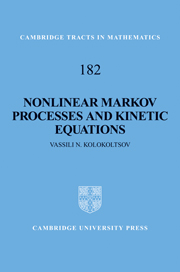Book contents
- Frontmatter
- Contents
- Preface
- Basic definitions, notation and abbreviations
- 1 Introduction
- Part I Tools from Markov process theory
- 2 Probability and analysis
- 3 Probabilistic constructions
- 4 Analytical constructions
- 5 Unbounded coefficients
- Part II Nonlinear Markov processes and semigroups
- Part III Applications to interacting particles
- Appendices
4 - Analytical constructions
from Part I - Tools from Markov process theory
Published online by Cambridge University Press: 05 July 2014
- Frontmatter
- Contents
- Preface
- Basic definitions, notation and abbreviations
- 1 Introduction
- Part I Tools from Markov process theory
- 2 Probability and analysis
- 3 Probabilistic constructions
- 4 Analytical constructions
- 5 Unbounded coefficients
- Part II Nonlinear Markov processes and semigroups
- Part III Applications to interacting particles
- Appendices
Summary
Chapter 3 was devoted to the construction of Markov processes by means of SDEs. Here we shall discuss analytical constructions. In Section 4.1 we sketch the content of the chapter, making, in passing, a comparison between these two approaches.
Comparing analytical and probabilistic tools
Sections 4.2 and 4.3 deal with the integral generators corresponding probabilistically to pure jump Markov processes. The basic series expansion (4.3), (4.4) is easily obtained analytically via the du Hamel principle, and probabilistically it can be obtained as the expansion of averages of terms corresponding to a fixed number of jumps; see Theorem 2.35. Thus for bounded generators both methods lead to the same, easily handled, explicit formula for such processes. In the less trivial situation of unbounded rates the analytical treatment given below rapidly yields the general existence result and eventually, subject to the existence of a second bound, uniqueness and non-explosion. However, if the process does explode in finite time, leading to non-uniqueness, specifying the various processes that arise (i.e. solutions to the evolution equation) requires us to fix “boundary conditions at infinity”, and this is most naturally done probabilistically by specifying the behavior of a process after it reaches infinity (i.e. after explosion). We shall not develop the theory in this direction; see, however, Exercise 2.7.
- Type
- Chapter
- Information
- Nonlinear Markov Processes and Kinetic Equations , pp. 102 - 130Publisher: Cambridge University PressPrint publication year: 2010



